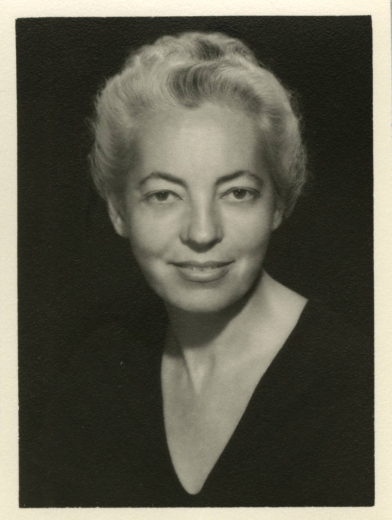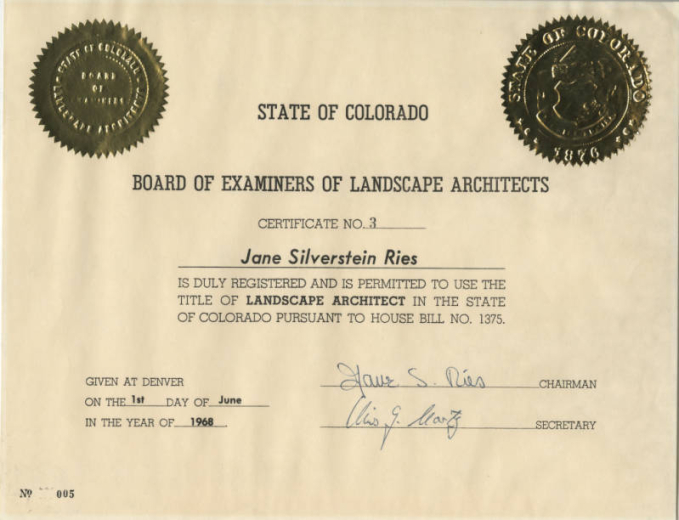Denver's first female landscape architect, Jane Silverstein Ries, created gardens around the state that were easy to grow in Colorado's unique environment.
Julia Jane Silverstein was born in Denver in 1909 to a wealthy Russian-American family. She loved bicycles, art, and nature. She knew from a young age she did not want to get married or follow any of the traditional roles for women. She wanted to spend her life working outside the home.
After Julia Jane graduated from East High School, she went to the University of Colorado to study Greek. After a year, she decided she did not want to study languages any more. She wanted to do something more creative. Julia Jane’s mother told her she should go to school to become a landscape architect. Her first response was “I love it – what is it?” When Julia Jane learned that landscape architects design beautiful gardens for a living, she knew that was what she wanted to do.
Julia Jane applied to Harvard University, but was not accepted because Harvard only took male students. Instead, she went to the Lowthorpe School of Landscape Architecture for Women. Julia Jane wanted to go there because many professors who taught landscape architecture to boys at Harvard taught classes to girls at Lowthorpe.
When Julia Jane graduated in 1932, she decided to return to Denver. Her first jobs were making gardens for family friends. She charged five dollars a project. After a year she was hired by a landscape architecture firm. She helped design gardens for the University of Colorado. In 1935, Julia Jane decided that she wanted to do what not many women did at the time – start her own company.
The earliest jobs Julia Jane’s business had were private gardens for smaller homes. She became known for her beautiful gardens throughout Denver. She wanted her gardens to give people privacy in the city. She used Colorado plants that did not need a lot of water.
Word about Julia Jane’s talent spread through Denver. Soon her gardens were all over the city. She made designs for the Denver Botanic Gardens, the Denver Country Club, the Denver Art Museum, and the Governor’s Mansion. She hired two assistants to help her keep up with all the gardens people wanted.
When Jane was forty-five, she did something she said she would never do. She got married. Her husband was a businessman named Henry Ries. Henry loved dogs and nature like Julia Jane did. He also traveled five months a year for business, so Julia Jane could spend plenty of time by herself. After they got married, Julia Jane Silverstein changed her name to Jane Silverstein Ries.
Jane took her work as a landscape architect very seriously. She was worried that there were no official standards for becoming a landscape architect in Colorado. Many states required landscape architects to go to school and pass tests before they were allowed to work. In Colorado, anyone could charge people to design gardens, even if they did not know what they were doing. Many people in Denver were upset because they paid for gardens that were not designed well. Jane wanted to change this.
Jane worked to pass a law in Colorado so only people who were trained could call themselves landscape architects. The law passed in 1968. The Colorado State Board of Landscape Architects was formed to regulate who could work as a landscape architect. Jane happily took the tests to show she was qualified for her job. She became Colorado’s first official female landscape architect.
Jane wanted to work to make the world around her a better place. She helped save many historic buildings that were going to be torn down. She also helped restore historic gardens, including the gardens at the Molly Brown House.
Jane wanted people to be able to enjoy beautiful gardens even if they did not have them at home, so she helped create many parks around Denver. She taught people how important it was to have gardens that worked with the environment instead of against it.
Jane thought it was very important for women to be able to follow their dreams, so she became a mentor for many female landscape architects. Three of the women she mentored founded Land Mark Design, an important Denver Landscape Architecture firm. Jane became a consultant for Land Mark Design after she stopped working full time at the age of eighty.
Many people honored Jane for her work in Denver. The Jane Silverstein Ries Foundation was named after her in 1997. The foundation continues Jane's work to use the best plants for the Colorado environment in gardens. She was made a member of the Colorado Women's Hall of Fame in 1999.
Jane passed away in 2005. Later that year, she was given the American Society of Landscape Architects Medal, the highest honor a landscape architect can receive.
Colorado landscape architects still feel Jane's impact today. The Jane Silverstein Ries Foundation gives scholarships and grants to promote sustainable gardens. Many people who work as landscape architects in Colorado studied with her or are inspired by her gardens. Her gardens can still be seen all over Colorado, where they are enjoyed by hundreds of people each day.
traditional – a way of thinking or acting that has been done by a group of people for a long time
landscape architect – a person whose job is to plan and create outdoor spaces like parks and gardens
design – to plan and make something
firm – a business with two or more partners
regulate – rules to bring order to the actions of a group
qualified –trained to do a job well
restore – to bring back to its original state
mentor – someone who teaches and gives advice to a younger or less experienced person
impact – the impression left by someone or something on the world around them
sustainable – using natural resources without destroying them
Would we know about Jane Silverstein Ries today if she was born to a poor immigrant family instead of a wealthy one?
Why do you think Jane was so interested in preserving the environment?
Have you ever seen a garden designed by Jane Silverstein Ries? Where would you go to find out?
Do you think any gardens in your area were created by a landscape architect? Why or why not?
Jane Silverstein Ries Online Exhibit (Lots of great photos and video)
Jane Silverstein Ries Manuscript Collection (Primary sources such as letters, drawings, and photos that can be seen in person on the 5th floor of the DPL Central Branch)
Biography Clipping Files (Newspaper, magazine, and journal articles about Jane Silverstein Ries that can be seen in person on the 5th floor of the DPL Central Branch)
Biography of Jane Silverstein Ries from the Cultural Landscape Foundation
Jane Silverstein Ries in the Colorado Women's Hall of Fame
Jane Silverstein Ries' winning nomination for the ASLA Medal





